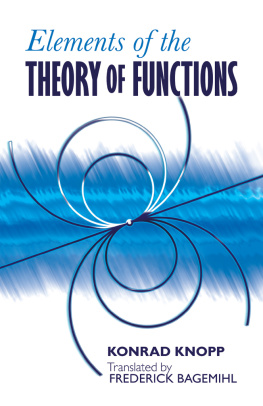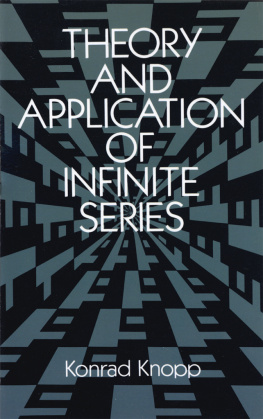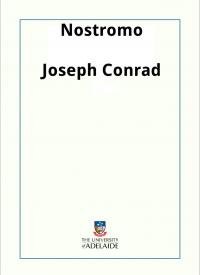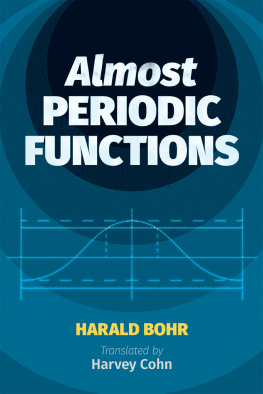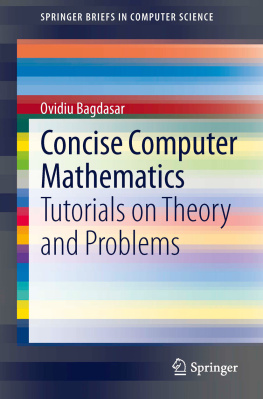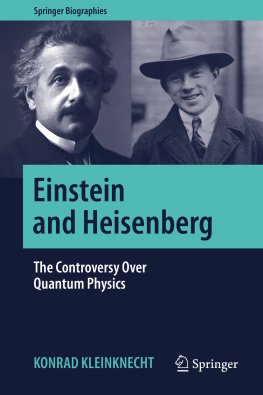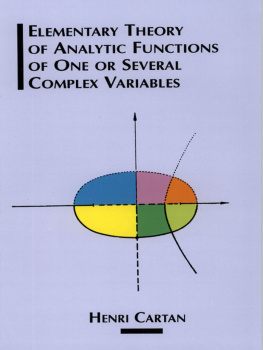Konrad Knopp - Elements of the Theory of Functions
Here you can read online Konrad Knopp - Elements of the Theory of Functions full text of the book (entire story) in english for free. Download pdf and epub, get meaning, cover and reviews about this ebook. year: 2016, publisher: Dover Publications, genre: Children. Description of the work, (preface) as well as reviews are available. Best literature library LitArk.com created for fans of good reading and offers a wide selection of genres:
Romance novel
Science fiction
Adventure
Detective
Science
History
Home and family
Prose
Art
Politics
Computer
Non-fiction
Religion
Business
Children
Humor
Choose a favorite category and find really read worthwhile books. Enjoy immersion in the world of imagination, feel the emotions of the characters or learn something new for yourself, make an fascinating discovery.
- Book:Elements of the Theory of Functions
- Author:
- Publisher:Dover Publications
- Genre:
- Year:2016
- Rating:4 / 5
- Favourites:Add to favourites
- Your mark:
- 80
- 1
- 2
- 3
- 4
- 5
Elements of the Theory of Functions: summary, description and annotation
We offer to read an annotation, description, summary or preface (depends on what the author of the book "Elements of the Theory of Functions" wrote himself). If you haven't found the necessary information about the book — write in the comments, we will try to find it.
Elements of the Theory of Functions — read online for free the complete book (whole text) full work
Below is the text of the book, divided by pages. System saving the place of the last page read, allows you to conveniently read the book "Elements of the Theory of Functions" online for free, without having to search again every time where you left off. Put a bookmark, and you can go to the page where you finished reading at any time.
Font size:
Interval:
Bookmark:
Elements of the
THEORY OF FUNCTIONS
KONRAD KNOPP
Translated by
FREDERICK BAGEMIHL
DOVER PUBLICATIONS, INC.
Mineola, New York
Copyright
Copyright 1952, 1980 by Dover Publications, Inc.
All rights reserved.
Bibliographical Note
This Dover edition, first published in 1952 and reissued in 2016, is a new English translation of Elemente der Funktionentheorie.
Library of Congress Catalog Card Number: 53-7031
International Standard Book Number
ISBN-13: 978-0-486-60154-0
ISBN-10: 0-486-60154-4
Manufactured in the United States by RR Donnelley
60154420 2016
www.doverpublications.com
CONTENTS
Elements of the
THEORY OF FUNCTIONS
SECTION I COMPLEX NUMBERS AND THEIR GEOMETRIC REPRESENTATION
CHAPTER I
FOUNDATIONS
1. Introduction
The name Theory of Functions is used to denote all those investigations which arise if one seeks to transfer the problems and methods of real analysis (i.e., differential and integral calculus, and related fields) to the case in which all numerical quantities (constants, independent and dependent variables) that appear are permitted to be complex numbers, that is, numbers of the form  . Early and quite automatically such considerations forced their way into investigations connected with various problems in real analysis, and have been carried out, in conjunction with the solution of these problems, in the course of centuries,hesitantly at first, but soon with ever greater success (see for further details). Today the theory of functions is one of the most extensive and important branches of higher mathematics.
. Early and quite automatically such considerations forced their way into investigations connected with various problems in real analysis, and have been carried out, in conjunction with the solution of these problems, in the course of centuries,hesitantly at first, but soon with ever greater success (see for further details). Today the theory of functions is one of the most extensive and important branches of higher mathematics.
In these Elements of the Theory of Functions we shall treat only those topics which are simplest, but which are at the same time most important for the further development of the theory.concept of sets of numbers, the limit concept, and closely related matters, in particular the theory of infinite series, are extended to complex quantities, or, as we say briefly, to the complex domain. Further, we shall carry over the notion of function and its most important properties to the case in which independent and dependent variables are complex. When combined with the limit concept, this yields the foundations of a differential calculus for functions of a complex variable. Finally, we shall study more closely the so-called elementary functions, including the rational, and, in particular, the linear, functions, the exponential function, the trigonometric functions, and several others, as well as their inverses, such as the logarithm and the cyclometric functions. The extension of the integral calculus to the complex domain, however, is not regarded as belonging properly to the elements of the theory of functions.
We shall see () that the operations performed on complex numbers, and, eventually, that all the investigations just mentioned, can be visualized, in a number plane or on a number sphere, even more vividly than in the real domain, This forms the content of that part of our theory which is called geometric theory of functions.
It is evident from what has been said, that in order to be able to understand this little book, a knowledge of the foundations of real analysis and of the elements of analytic geometry is indispensable, inasmuch as the extension to the complex domain is accomplished after the pattern of real analysis, and use is made of simple geometric facts for purposes of visualization. So as to have a fixed point of departure, we shall state in what is most fundamental as regards the construction of analytic geometry.
2. The system of real numbers
We presuppose familiarity with the system of real numbers, of course, as far as its practical use is concerned; but because of its fundamental importance, we shall present briefly here the essential ideas which lead to its construction.
The starting point of all investigations concerning numbers is the sequence of natural numbers, 1, 2, 3, ..., and the two operations on them: addition and multiplication. The necessity of performing the inverses of these operations presently compels the introduction of 0 (zero), negative numbers, and, finally, fractions. The totality of integral, fractional, positive and negative numbers, and zero, is called the system of (real) rational numbers.
One can operate with these numbers, which are now denoted for brevity by single Roman letters, according to certain rules which are called the fundamentals laws of arithmetic. These are the following, in which by numbers we mean, for the present, only the rational numbers just referred to:
I. F UNDAMENTAL LAWS OF EQUALITY AND ORDER
1. The set of numbers is an ordered set; i.e., if a and b are any numbers, they satisfy one, and only one, of the relations

This order obeys these additional laws:
2. a = a for every number a.
3. a = b implies b = a.
4. If a = b and b = c, then a = c.
5. If ab and b < c, or if a < b and bc, then a < c.
All numbers which are greater than zero are called positive, all numbers which are less than zero are called negative. If a number is equal to zero, we also say that it vanishes.
II. F UNDAMENTAL LAWS OF ADDITION
1. Every pair of numbers a and b can be added; the symbol (a + b) or a + b always represents a definite number, the sum of a and b.
This formation of sums obeys these laws:
2. If a = aand b = b, then a + b = a + b. (If equals are added to equals, the sums are equal.)
3. a + b = b + a. (Commutative law.)
4. (a + b) + c = a + (b + c). (Associative law.)
5. a < b implies a + c < b + c. (Monotonic law.)
III. F UNDAMENTAL LAW OF SUBTRACTION
The inverse of addition can always be performed; i.e., if a and b are any numbers, there exists a numberx such that a + x = b.
The number x thus determined is called the difference of b and a, and is denoted by (ba).
IV. F UNDAMENTAL LAWS OF MULTIPLICATION
1. Every pair of numbers a and b can be multiplied; the symbol ab or ab always represents a definite number, the product of a and b.
This formation of products obeys these laws:
2. If a = aand b = b, then ab = ab. (If equals are multiplied by equals, the products are equal.)
3. ab = ba. (Commutative law.)
4. (ab)c = a(bc). (Associative law.)
5. (a + b)c = ac + bc. (Distributive law.)
6. If a < b, and c > 0, then ac < bc. (Monotonic law.)
The four rules of sign and, as a supplement to them, the result that

follow in the simplest fashion, but certainly as demonstrable facts, from the fundamental laws enumerated thus far. The four rules of sign assert, in particular, that
Next pageFont size:
Interval:
Bookmark:
Similar books «Elements of the Theory of Functions»
Look at similar books to Elements of the Theory of Functions. We have selected literature similar in name and meaning in the hope of providing readers with more options to find new, interesting, not yet read works.
Discussion, reviews of the book Elements of the Theory of Functions and just readers' own opinions. Leave your comments, write what you think about the work, its meaning or the main characters. Specify what exactly you liked and what you didn't like, and why you think so.

